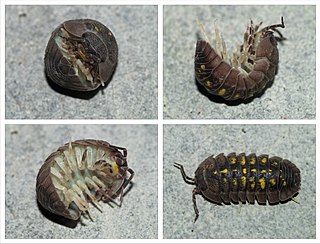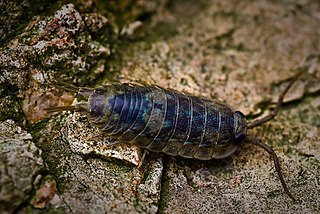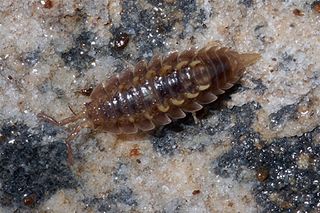
Isopoda is an order of crustaceans. Members of this group are called isopods and include both aquatic species, and terrestrial species such as woodlice. All have rigid, segmented exoskeletons, two pairs of antennae, seven pairs of jointed limbs on the thorax, and five pairs of branching appendages on the abdomen that are used in respiration. Females brood their young in a pouch under their thorax.

Armadillidiidae is a family of woodlice, a terrestrial crustacean group in the order Isopoda. Unlike members of some other woodlice families, members of this family can roll into a ball, an ability they share with the outwardly similar but unrelated pill millipedes and other animals. This ability gives woodlice in this family their common names of pill bugs or roly polies. Other common names include slaters, potato bugs, butchy boys, and doodle bugs. Most species are native to the Mediterranean Basin, while a few species have wider European distributions. The best-known species, Armadillidium vulgare, was introduced to New England in the early 19th century and has become widespread throughout North America.

Porcellio scaber, is a species of woodlouse native to Europe but with a cosmopolitan distribution. They are often found in large numbers in most regions, with many species preying on them.

Oniscus asellus, the common woodlouse, or common shiny woodlouse is one of the largest and most common species of woodlouse native to the British Isles and Western and Northern Europe, growing to lengths of 16 mm and widths of 6 mm.

Ligia oceanica, the sea slater, common sea slater, or sea roach, is a woodlouse, living in the littoral zone—rocky seashores of the European North Sea and Atlantic coastlines.

Woodlice are terrestrial isopods in the suborder Oniscidea. Their name is derived from being often found in old wood, and from louse, a parasitic insect, although woodlice are neither parasitic nor insects.

A giant isopod is any of the almost 20 species of large isopods in the genus Bathynomus. They are abundant in the cold, deep waters of the Atlantic, Pacific, and Indian Oceans. Bathynomus giganteus, the species upon which the generitype is based, is often considered the largest isopod in the world, though other comparably poorly known species of Bathynomus may reach a similar size. The giant isopods are noted for their resemblance to the much smaller common woodlouse, to which they are related.

Trichoniscus pusillus, sometimes called the common pygmy woodlouse, is one of the five most common species of woodlice in the British Isles. It is acknowledged to be the most abundant terrestrial isopod in Britain. It is found commonly across Europe north of the Alps, and has been introduced to Madeira, the Azores and North America.

Ligidium hypnorum is a species of woodlouse found across Europe and western Asia. It is a fast-moving, active species that rarely grows longer than 9 mm (0.35 in). It is dark and shiny, and is similar in appearance to the common species Philoscia muscorum, and also the rarer Oritoniscus flavus. In Great Britain, it was first discovered at Copthorne Common, Surrey, in 1873, and most later records are also from South East England. It is considered a good indicator species for ancient woodland.

Oniscus is a genus of woodlice. It comprises five species, three of which are confined to northwestern Iberia, one to the Pyrenees, and one of which, O. asellus, is widespread across Europe and has been introduced to the Americas .

Hemilepistus reaumuri is a species of woodlouse that lives in and around the deserts of North Africa and the Middle East, "the driest habitat conquered by any species of crustacean, not including insects which are now known to be crustaceans pancrustacea". It reaches a length of 22 mm (0.87 in) and a width of up to 12 mm (0.47 in), and has seven pairs of legs which hold its body unusually high off the ground. The species was described in the Description de l'Égypte after the French Campaign in Egypt and Syria of 1798–1801, but was first formally named by Henri Milne-Edwards in 1840 as Porcellio reaumuri. It reached its current scientific name in 1930 after the former subgenus Hemilepistus was raised to the rank of genus.

Platyarthridae is a family of woodlice, containing the following genera:

The Arcturidae are a family of marine isopod crustaceans in the suborder Valvifera. Members of the family resemble woodlice and are found globally in cooler areas in shallow seas.

Mesoniscus is a genus of woodlice, placed in its own family, Mesoniscidae, and section, Microcheta. It contains two species – Mesoniscus alpicolus and Mesoniscus graniger – that live in Central and Eastern Europe, mostly in and around caves.
Suarezia is a genus of woodlice, in the family Scleropactidae, containing the two species Suarezia differens and Suarezia heterodoxa, both of which are endemic to Madagascar.
Feadillo principensis is an endemic species of armadillo woodlice, a land crustacean isopods of the family Armadillidae that lives in the island of Príncipe in São Tomé and Príncipe. The species was described in 1983 by Helmut Schmalfuss and Franco Ferrara.
Annobodillo is a genus of armadillo woodlice, terrestrial crustacean isopods of the family Armadillidae. The only species within the genus is Annobodillo coecus, which is endemic to the island of Annobón in Equatorial Guinea. The species and the genus were described in 1983 by Helmut Schmalfuss and Franco Ferrara. The name of the genus Annobodillo refers to the island Annobón.

Deto is a genus of woodlice in the family Detonidae. Members of this genus can be found along the coasts in areas of New Zealand, Namibia, South Africa and Australia.

Armadillidium maculatum, also known as the zebra isopod or zebra pillbug is an Armadillidium species of woodlouse, named for its black and white patterns. It is native to southern France. It is quite popular as pets or vivarium cleaners, due to their ability to break down various waste.


















